East West Lifestyle
Bringing the Ancient Theater of the Silk Road to Los Angeles
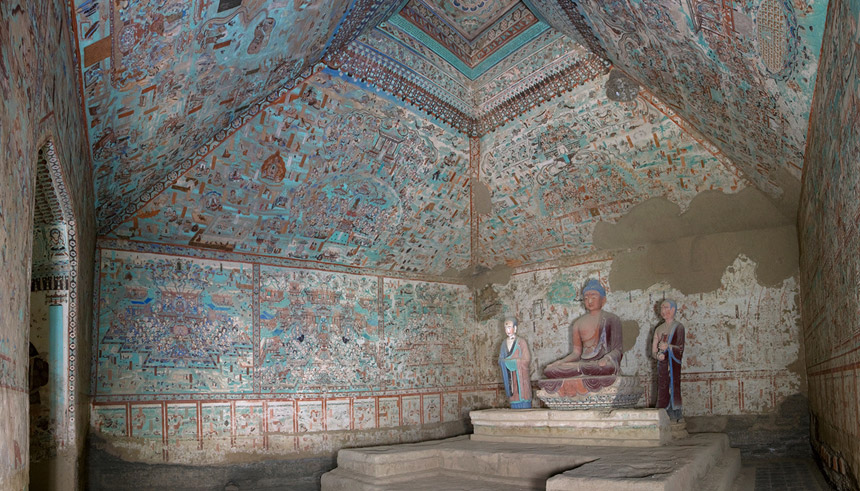
A comprehensive exhibition of rare art from the Silk Road now on view at the Getty Center
At the remote edge of the Gobi Desert, Dunhuang emerged as a global hub of art, culture, and trade along the Silk Road. For around a thousand years, 492 grottoes at the Mogao Caves were carved by hand into a mile-long stretch of cliff face, and painted with elaborate visual narratives covering the walls and ceilings. The nearly 500,000 square feet of murals contained within offer a rare window into a vibrant multicultural past along the Silk Road.
Now a UNESCO World Heritage Site, the Mogao Caves in Dunhuang were nearly lost to history, engulfed by desert sands for four centuries. Despite its internationally celebrated status today, the sheer remoteness of the site remains in sharp contrast with the lush artwork depicting expansive parallel worlds just within its rocky cliffs.
“The scale and quality of the wall paintings and their location in this unspoiled and stark desert setting is what I find most remarkable about the Mogao Grottos” said Tim Whalen, Director of the Getty Conservation Institute. “It is one of the world’s most impressive and complete cultural heritage sites and it bears witness to a millennium of human artistic achievement and cultural exchange.”
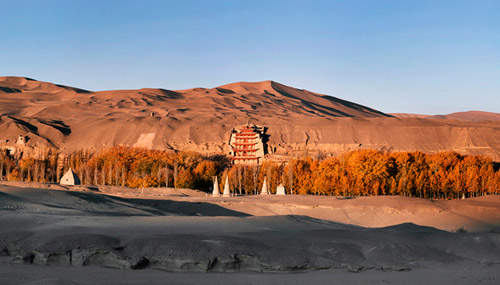
"The scale and quality of the wall paintings and their location in this unspoiled and stark desert setting is what I find most remarkable about the Mogao Grottos."
Arguably the crown jewel of sites along the Silk Road, the Mogao Caves at Dunhuang is the focus of a first of its kind exhibition at the Getty Center in Los Angeles. “The challenges for the exhibition curators were at times truly mind-boggling. How to authentically present the wonders of the site to viewers halfway around the world?” says Marcia Reed, Chief Curator at the Getty Research Institute.
"The Cave Temples of Dunhuang: Buddhist Art on China’s Silk Road" exhibition will feature full-scale hand-painted replica caves transported from China, an immersive 3D tour experience, and three exhibit halls showcasing some of the most prized artifacts from international collections, many of which have never traveled to North America.
The exhibition is the culmination of a more than 25-year collaboration between the Getty Conservation Institute (GCI) and the Dunhuang Academy to preserve the fragile heritage of the ancient site, while managing an increase in visitors and promoting recognition of its importance worldwide. The GCI and Dunhuang Academy dedicated more than ten years to the conservation and study of Cave 85, which culminated in the development of the China Principles, establishing a set of national conservation guidelines for cultural heritage conservation and management.
“This exhibition highlights the historical importance, artistic significance, as well as the conservation issues facing this cultural gem located on a nexus of the silk route,” says Boon Hui Tan, VP of Global Arts and Cultural Programs and Director at Asia Society and Director of the Asia Society Museum.
“I think the exhibition will surprise people, showing how global China was from the 4th to the 14th century. Plus it’s beautiful, so it’s so easy to appreciate,” says Mimi Gates, Board Chairman of the Dunhuang Foundation and champion of the exhibition for the past five years. “I think this exhibition gives Americans a chance to understand the depth and richness represented by Dunhuang. The fact that there was this whole intersection of cultures along these trade routes; it’s very relevant to our age because of all the global interaction.”
Dunhuang was a place where major world cultures from Greece and Rome, the Persian Empire, Middle East, Central Asia and China came together. The exhibition also coincides with a significant shift in present China’s role on the world stage through the One Belt One Road initiative. From 2013 to 2015 Chinese policy banks and other government-backed institutions have invested over USD $100b in One Belt One Road countries.
"Humans aren’t purely economic animals. As I see it, economic exchange inevitably brings with it cultural exchange. "

“We believe that bridging the East and West goes beyond trade finance or import export. It’s truly about the people, the culture. There’s so much more beyond the financial bridge,” says Emily Wang, Senior Vice President Director of Marketing and Community Development at East West Bank, which is the lead corporate sponsor of the exhibition.
The exhibition is bringing together a wide range of stakeholders to explore the cultural dialogue around Dunhuang. “We’re using the Getty exhibition as a launching pad, we’re looking to partner with organizations to do projects related to Dunhuang over the next 10 – 15 years,“ says Susan Pertel Jain, director of the UCLA Confucius Institute.
A series of programming around the exhibition will include a two-day symposium with leading international scholars, film screenings of the 1927 silent film Cave of the Silken Web, and musical events, including an evening with composer Tan Dun. “We’re working with the UCLA department of Ethnomusicology to produce a musical event combining Persian, Turkish, Chinese, Indian, Uzbek and Tibetan music, in traditional ensemble and new ensembles,” says Pertel Jain.
Logistical challenges
A vast team of curators and institutions collaborated on an innovative and multifaceted approach to recreating the experience of visiting Dunhuang for international audiences in Los Angeles. They commissioned two new replica caves, which took artists from the Dunhuang Academy three years to complete at the site of the Mogao Caves using authentic period materials and methods.
Transporting the replica caves to Los Angeles required large-scale coordination with in-kind sponsors Air China and China Cosco Shipping. Once the materials arrived in Los Angeles, the Getty constructed a giant climate-controlled tent to house the replicas and flew over specialized teams who spent three weeks completing the installation.
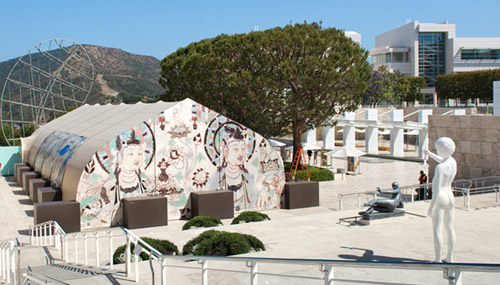
" The challenges for the exhibition curators were at times truly mind-boggling. How to authentically present the wonders of the site to viewers halfway around the world?"
In addition to the experience of entering full-scale replica caves, visitors can also take an immersive VR tour of cave 45. “This is the first time in a museum setting that anyone has used this new spherical stereoscopic 3D technology. It gives a more volumetric or immersive experience than regular VR, using a special 360 degree dome shader. It was a year-long process to merge the 2D photographs and merge them into the 3D geometry for the entire cave,” explains Garson Yu, founder and creative director of the creative graphics and storytelling firm yU+co.
“Cave 45 was really the ideal cave to do this because it has one of the best preserved sets of sculptures. It’s also a beautiful cave,” explains Jeffrey Levin of the Getty Conservation Institute who worked with yU+co on the narrative. “One of the great achievements of this was taking the individual 2D images, modelling them into a 3D landscape, and creating a fluid experience.”
A rare glimpse from European collections
After the fortuitous rediscovery of the Mogao Caves among the desert sands in the 19th century, new mysteries surrounding the site have continued to spring up. A sealed passage concealed within another Grotto revealed the so-called library cave, containing some 40,000 texts, paintings and objects; many of which ended up in the collections of the British Museum, the British Library, the Musee Guimet, and the French National Library where they continue to be studied.
The backstory of how these artifacts survived to the present is not well understood. “Why was the library cave sealed? Was it to protect these objects? Were they fearing raids to the site or the town?” asks Julia Grimes, Dunhuang exhibition project assistant, “This constellation of objects were all in the library cave at one point, and they’re being reunited on the Getty campus for this exhibition.”
“If we were able to, we would travel the show, but it’s exclusive to the Getty because of the restrictions on the loans. The artifacts are all silk and paper, which makes them very fragile and long-term exposure to light can damage the works, so they can only be seen for a limited period of time,” says Gates.
"If we were able to, we would travel the show, but it’s exclusive to the Getty. The artifacts are all silk and paper, which makes them very fragile."

The artifacts from the library cave on show at the Getty are among the best direct evidence of the cultural and technological exchange along the Silk Road. “The variety of media chosen for this exhibition — paintings, tapestries, banners, wooden sculptures, manuscripts, and printed works on paper — reflect the complex ideas, beliefs, and artistic styles of the diverse populations who traveled through and traded and lived at the site,” says Reed.
“Images and written documents make it clear that Manicheans, Christians, Zoroastrians, and Jews also had a presence on the Silk Route. We have written documents from the site in seventeen different languages. There is still so much to be learned from the rich legacy we have from this site,” says Tan.
“Textual sources about early trade are few and we rely much on material culture – the archaeology and artifacts — to learn about Dunhuang’s role on the Silk Road,” says Susan Whitfield, historian at the International Dunhuang Project and the British Library. Among the objects on display is a copy of the Diamond Sutra from 868 CE, making it the world’s oldest dated complete printed book. “This copy of the Diamond Sutra shows the ingenuity of humans in inventing new technologies — such as printing,” says Whitfield, who will give a lecture on the Diamond Sutra.
An ancient theater: illumination in the dark
Even to modern visitors, the sensory experience of entering the Mogao Caves is enchanting. Over 650 miles west of the nearest major city of Lanzhou (a formidable journey even today), visitors to the caves suddenly leave behind the arid desert surroundings and step into vast narrative worlds filled with exotic imagery in lush jewel-like colors. Intensifying the mystery of the experience is the unanswered question of how the ancient site was used and by whom?
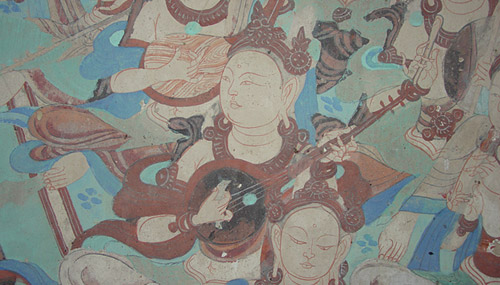
"I think the exhibition will surprise people, showing how global China was from the 4th to the 14th century. Plus it’s beautiful, so it’s so easy to appreciate."
“The caves were such fantastic complexes filled with rich decorations. But how much were the caves known to people? Were people coming for pilgrimage? Also, what other kinds of activities took place at the caves and during which periods? This remains a great mystery,” says Reed.
Though largely culturally Chinese, the convergence of so many cultural traditions and the relative geographic isolation of the Mogao Caves may have contributed to the singular aesthetic of the artwork. “When you look at the artwork at Dunhuang, what you see is everybody’s culture right there on the wall,” says Pertel Jain.
The large-format narrative panels were an ancient means of sharing complex stories. The fantastic larger-than-life themes, novel juxtaposition of distant peoples and customs, and transporting experience of entering into a dark space has attracted some comparisons to a modern industry in Los Angeles. “Hollywood is an example of art that’s illumination in the dark. What is Dunhuang?” says Pertel Jain.
“Great art and great culture is frequently based on telling a great story. During the 20th century, perhaps nothing told a story better than that revolutionary new medium of film — and Los Angeles rose out of the desert to become the film capital of the world and an important nexus of world culture, which it remains to this day. Like Los Angeles, Dunhuang rose out of the desert to become the crossroads of world culture and a power for inspired artistic creativity which survives as a true wonder of the world,” said Ted Lipman, CEO of the Robert H. N. Ho Family Foundation.
Powerful patrons behind the artistic heritage
While few signs of an advanced economic and social order that supported the Mogao Caves can be seen today, the sheer scale and sophistication of this artistic community over the centuries suggests powerful patrons. “There would have been designers or engineers of the space itself, groups of people doing the cutting and carving, artisans to prepare the wall surfaces and then lay the painting down. So it’s a very sophisticated and complex undertaking, and given the scale of that which would mean that at the site, or near the site there clearly would have been a group of workshops with highly skilled artisans, engineers and logisticians to make this possible,” says Whalen.
Fortunately there is some compelling information about the patrons that commissioned these caves throughout history. “In a number of the caves, the men‘s dress is more reflective of the nomadic or Central Asian traditions, which may point to the particular cultures of which the ruling elites sprang. But with the women, you’ll notice in most cases have fully adopted Chinese metropolitan fashion, they were extremely cosmopolitan ladies and they want you to know that,” says Grimes.
The Mogao Caves offer detailed depictions of many different ethnic and cultural groups, including diverse costumes and more than 40 varieties of musical instruments. “This exhibition serves as an educational tool for reaching contemporary audiences so that they can better understand how our actions today can impact our joint global heritage. The world of global trade and interaction that the treasures of Dunhuang and the Mogao caves document is of significance to current affairs,” says Tan.
An early globalization
Dunhuang’s role in history was influenced by its geographic location and the expansionist vision of Emperor Wu in the Han Dynasty. In 139 BCE Emperor Wu sent envoy Zhang Qian on a 13 year voyage to explore the far West, reaching the distant kingdoms of Ferghana, Bactria, and Parthia — around present day Iran. Zhang returned with reports of vast vineyards, heavenly horses, and markets eager for Chinese goods. In particular horses were highly coveted by Emperor Wu in order to transform China’s military capacity, resulting in a massive military campaign to the area of Uzbekistan and Tajikistan.
After expanding the great wall to the edge of the Gobi desert, Wu established Dunhuang as the westernmost outpost of the Han Dynasty. As a strategic impasse along one of the only traversable land routes in and out of the central plains of China, Dunhuang would play a crucial role as a trade gateway and base for diplomacy with non-Han nomadic tribes.
"Dunhuang was a very cosmopolitan environment. Today we talk about globalism, as if it was something we discovered and created, but in fact no. Globalism is ancient."
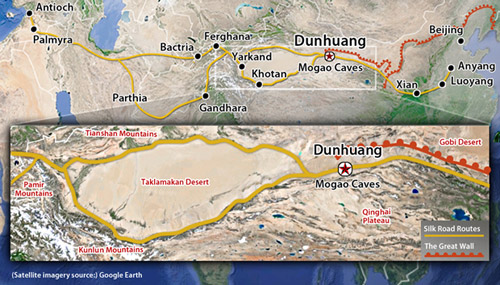
“I think we all have incredibly romantic notions about the Silk Road, where a caravan would start in Xi’an, and then find its way to Syria. In fact, I think the more we understand about the site and about the Silk Road, it’s that caravans would move back and forth along a certain stretch, but not necessarily the entire distance by one caravan as we envision it,” says Whalen. Even if this relay model of transcontinental trade implies a more regional understanding of the traders, that doesn’t necessarily mean the exclusive dominance of the local culture. “Dunhuang was a very cosmopolitan environment. Today when we talk about globalism, as if it was something we discovered and created, but in fact no. Globalism is ancient.”

